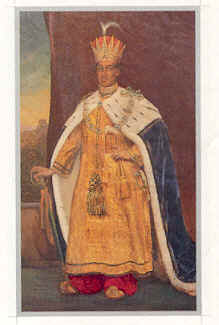
Back دولة أوده Arabic Oudh Catalan دولت اوده Persian Oudhin kuningaskunta Finnish अवध रियासत Hindi Stato di Oudh Italian ਅਵਧ ਰਿਆਸਤ Punjabi سلطنت اودھ PNB Ауд (княжество) Russian Ауд (држава) Serbian
Oudh Awadh | |||||||||||||
|---|---|---|---|---|---|---|---|---|---|---|---|---|---|
| 1572–1856 | |||||||||||||
 The Kingdom of Oudh in 1856 (red) | |||||||||||||
| Status |
| ||||||||||||
| Capital | |||||||||||||
| Common languages | Urdu and Persian (official), Awadhi (regional), English | ||||||||||||
| Religion | Shia Islam (official), Hinduism (majority), Sunni Islam, Jainism, Buddhism, Sikhism, Christianity | ||||||||||||
| Government |
| ||||||||||||
| Nawab/Padshah | |||||||||||||
• 1722–1739 | Saadat Ali Khan I (first) | ||||||||||||
• 1847–1856 | Wajid Ali Shah (last) | ||||||||||||
| Subedar | |||||||||||||
• 1722 | Girdhar Bahadur (last) | ||||||||||||
| History | |||||||||||||
• Independence from Mughal Empire | 26 January 1722 | ||||||||||||
• Annexation of Oudh | 1856 | ||||||||||||
| 5 – 25 June 1857 | |||||||||||||
| 3 March 1858 | |||||||||||||
• Merger of Oudh to North-Western Provinces | 1859 | ||||||||||||
| Area | |||||||||||||
| 62,072 km2 (23,966 sq mi) | |||||||||||||
| Currency | Rupee | ||||||||||||
| |||||||||||||


The Oudh State (/ˈaʊd/,[1] also Kingdom of Awadh, Kingdom of Oudh, Awadh Subah, Oudh Subah or Awadh State) was a Mughal subah, then an independent kingdom, and lastly a princely state in the Awadh region of North India until its annexation by the British in 1856. The name Oudh, now obsolete, was once the anglicized name of the state, also written historically as Oudhe.
As the Mughal Empire declined and decentralized, local governors in Oudh began asserting greater autonomy, and eventually Oudh matured into an independent polity governing the fertile lands of the Central and Lower Doab. With the British East India Company entering Bengal and decisively defeating Oudh at the Battle of Buxar in 1764, Oudh fell into the British orbit.
The capital of Oudh was in Faizabad, but the Company's Political Agents, officially known as "Residents", had their seat in Lucknow. At par existed a Maratha embassy, in the Oudh court, led by the Vakil of the Peshwa, until the Second Anglo-Maratha War. The Nawab of Oudh, one of the richest princes, paid for and erected a Residency in Lucknow as a part of a wider programme of civic improvements.[2]
Oudh joined other Indian states in an upheaval against British rule in 1858 during one of the last series of actions in the Indian rebellion of 1857. In the course of this uprising, detachments of the Bombay Army of the East India Company overcame the disunited collection of Indian states in a single rapid campaign. Determined rebels continued to wage sporadic guerrilla clashes until the spring of 1859. This rebellion is also historically known as the Oudh campaign.[3]
After the British annexation of Oudh by the Doctrine of Lapse, the North Western Provinces became the North Western Provinces and Oudh.[4]
- ^ "Oudh – definition of Oudh in English from the Oxford dictionary". Archived from the original on 9 September 2015. Retrieved 1 September 2015.
- ^ Davies, Philip, Splendours of the Raj: British Architecture in India, 1660–1947. New York: Penguin Books, 1987
- ^ Michael Edwardes, Battles of the Indian Mutiny, Pan, 1963, ISBN 0-330-02524-4
- ^ Ashutosh Joshi (1 January 2008). Town Planning Regeneration of Cities. New India Publishing. p. 237. ISBN 978-8189422820. Archived from the original on 3 March 2018. Retrieved 13 February 2016.

